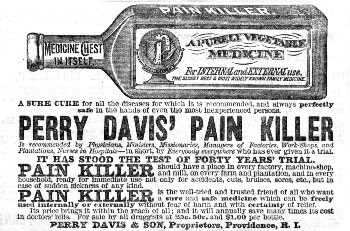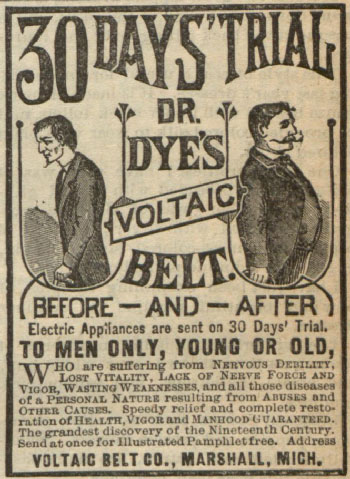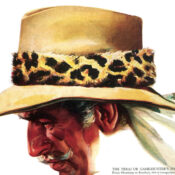Prior to the Pure Food and Drug Act of 1906, entrepreneurs could make any claim they wanted for their special medicines, herb tonics, electric belts, and hair restorers. Not only did these remedies usually not work, they sometimes caused more harm than good.
Many of these elixirs, remedies, and “vegetable restoratives” were heavily laced with alcohol, codeine, or opium. While the ads for patent medicines made all sort of promises, none was more fantastic than the promise of “satisfaction guaranteed.”
The makers of patent medicine might have actually believed in their product’s ability to cure, but they definitely believed in the power of advertising. Periodicals of the 19th century were filled with ads for patent medicines. The Post and of the 19th century seems to have avoided some of the more outrageous patent-medicine ads. Even so, we’ve found a few interesting examples.

The Saturday Evening Post
February 15, 1873
Medical marijuana: A doctor cures his only child of tuberculosis with cannabis.

The Saturday Evening Post
July 6, 1878
How many people jumped at the chance to lose “from two to five pounds per week”?

The Saturday Evening Post
October 4, 1879
Dr. Case warned that catarrh (a buildup of phlegm or mucus) could lead to tuberculosis (then the leading cause of death in America) but could be remedied by breathing fumes of wood tar.

The Country Gentleman
September 11, 1879
Florida Water was a cologne using orange scent. The fountain in the ad refers to the Fountain of Youth, which Ponce de Leon presumably found in Florida. Florida Water is still being sold (lanman-and-kemp.com) but without claims of health benefits.

The Country Gentleman
March 25, 1880
Today, we might wonder how a painkiller could be “always perfectly safe in the hands of even the most inexperienced persons.”

The Saturday Evening Post
January 29, 1881
This illustration appeared above a full-page ad for A.M. Richardson’s Wonderful Magneto-Galvanic Battery, which was claimed to revitalize and strengthen organs—without actually specifying which ones. The company recommended it for 56 different ailments, including meningitis, diabetes, heartburn, and “hysteria or fits.”

The Saturday Evening Post
January 30, 1883
“Speedy relief and complete restoration of Health, Vigor and Manhood guaranteed.” How could anyone not be satisfied with a promise like that?

The Saturday Evening Post
January 13, 2016
It’s only after you’ve read most of the ad for “Golden Medical Discovery” that you realize the grisly cartoon has nothing to do with the product.
Coming Soon from The Saturday Evening Post: Ads You’ll Never See Again
A special collector’s edition of The Saturday Evening Post filled with ads from the past that will delight, entertain — and sometimes shock — with images and concepts that are thoroughly inappropriate today. You’ll cringe when you see babies wrapped in then-brand-new cellophane. You’ll laugh out loud at Santa promoting a cigarette brand. You’ll wince at an ad that threatens housewives with a spanking for failing to complete their domestic chores. More than just an entertainment, the special issue offers a snapshot of attitudes about gender, childrearing, and marketing in an era that most readers will remember all too well.
It’s too early to order, but if you might be interested in purchasing this product, please click here and we’ll send you a notice when the special issue is available.
Become a Saturday Evening Post member and enjoy unlimited access. Subscribe now




Comments
I worked for a company years ago that was huge in the supplement industry. Supplements are not FDA approved so you could pretty much claim anything you wanted. Most of the products were indeed snake oil with no scientific proof of their benefit claims. I had a chance to see the raw organic materials coming in from overseas and I remember 55 gallon containers filed with what looked like sticks and twigs.
Ah yeah, the snakes are still making and selling oil.
I love Saturday Evening Post, have read it since I was quite young and I am 86 now! These ads are very entertaining. Thanks for sending them.
What a great feature: 19th century ‘snake oil’ ads! They definitely set the tone for many of the misleading ads of the 20th and 21st centuries, BUT I think they also helped fuel the demand for legitimate cures and solutions to these problems.
Dr. Dye’s Voltaic Belt seems kind of like what today would be a testosterone type ad, the Botanic anti-fat ad isn’t too far removed from what we still see today. The one with cannabis (indica no less!) would probably be more popular than ever now. (I certainly smell it enough when I’m out and about nowadays…)
I’m really looking forward to the forthcoming ‘Ads You’ll Never See Again’ Post softcover book. Some are cringe worthy, sexist etc., but they were what they were for their time. No doubt many ads from the present will seem just as old fashioned in the future–if not more so.